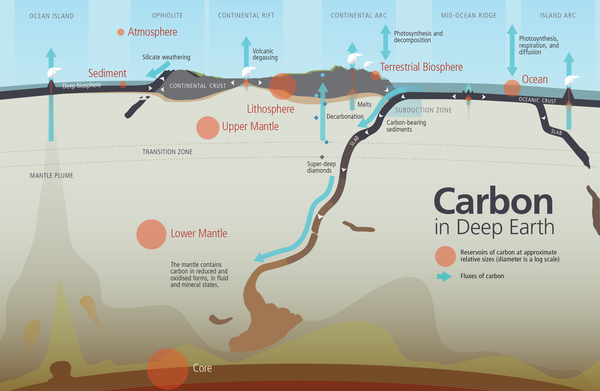
by Bill Schlesinger
Within the past decade or so, the global carbon cycle has become the subject of newspaper articles, cocktail party conversation, and public policy. Most of us are aware that carbon moves between the atmosphere, land plants, and the oceans each year—in quantities measured in billions of metric tons. We also know that burning fossil fuels has added a large new flux to the cycle, about 10 billion metric tons in recent years.
But, carbon also moves in other pathways only weakly linked to its movements at the surface of the Earth. Each year, a small amount of carbon is deposited on the ocean floor in the form of dead organisms and their carbonate shells. This deposition constitutes a long-term “sink” for carbon in its global cycle. Oceans have existed on Earth for about 3.8 billion years, but the average age of the oceanic crust today is only about 65 million years. Where has the rest of the oceanic crust and its carbon content gone?
The oceanic crust is not static. New crust is generated by submarine volcanoes at mid-ocean ridges, and it moves laterally until it reaches what are known as subduction zones, where thick slabs of the crust pass downward into the Earth’s mantle where they are subject to great heat and pressure. The carbon deposited on the seafloor is carried into the mantle, and some of this carbon and other light elements are released as gases that return to the Earth’s surface in volcanic emissions. Subduction and volcanic emissions compose a long-term, slow cycle for carbon and these elements.
The best estimates of the subduction of carbon are about 100 million metric tons per year—just about equivalent to the estimates of the annual volcanic emissions of carbon dioxide to the atmosphere. Other volatile elements that also show up in volcanic emissions, such as nitrogen, are also closely balanced to their deposition on the seafloor over long time periods. This means that through Earth’s history, nearly every atom of carbon has spent some time—perhaps a billion years—in the deep Earth, before it returns to the familiar cycle at the surface of the Earth, where it may end up in your thumb nail.
Since the fast carbon cycle at the Earth’s surface is linked to the slow carbon cycle passing through the deep Earth, it would be nice to think that the deposition and subduction of carbon in ocean sediments could act as a sink for carbon dioxide that otherwise accumulates in the atmosphere, where it causes changes in climate. Indeed, the deep carbon cycle will prevail, if we are willing to wait a billion years or so. We have much to do in the meantime.
References:
Dasgupta, R and M.M. Hirschmann. 2010. The deep carbon cycle and melting in Earth’s interior. Earth and Planetary Science Letters 298: 1-13.
Marty, N. 2012. The origins and concentrations of water, carbon, nitrogen, and noble gases on Earth. Earth and Planetary Science Letters 313: 56-66.
Seton, M. and 8 others. 2020. A global data set of present-day oceanic crustal age and seafloor spreading parameters. Geochemistry, Geophysics, and Geosystems 21: doi: 10.1029/2020GC009214